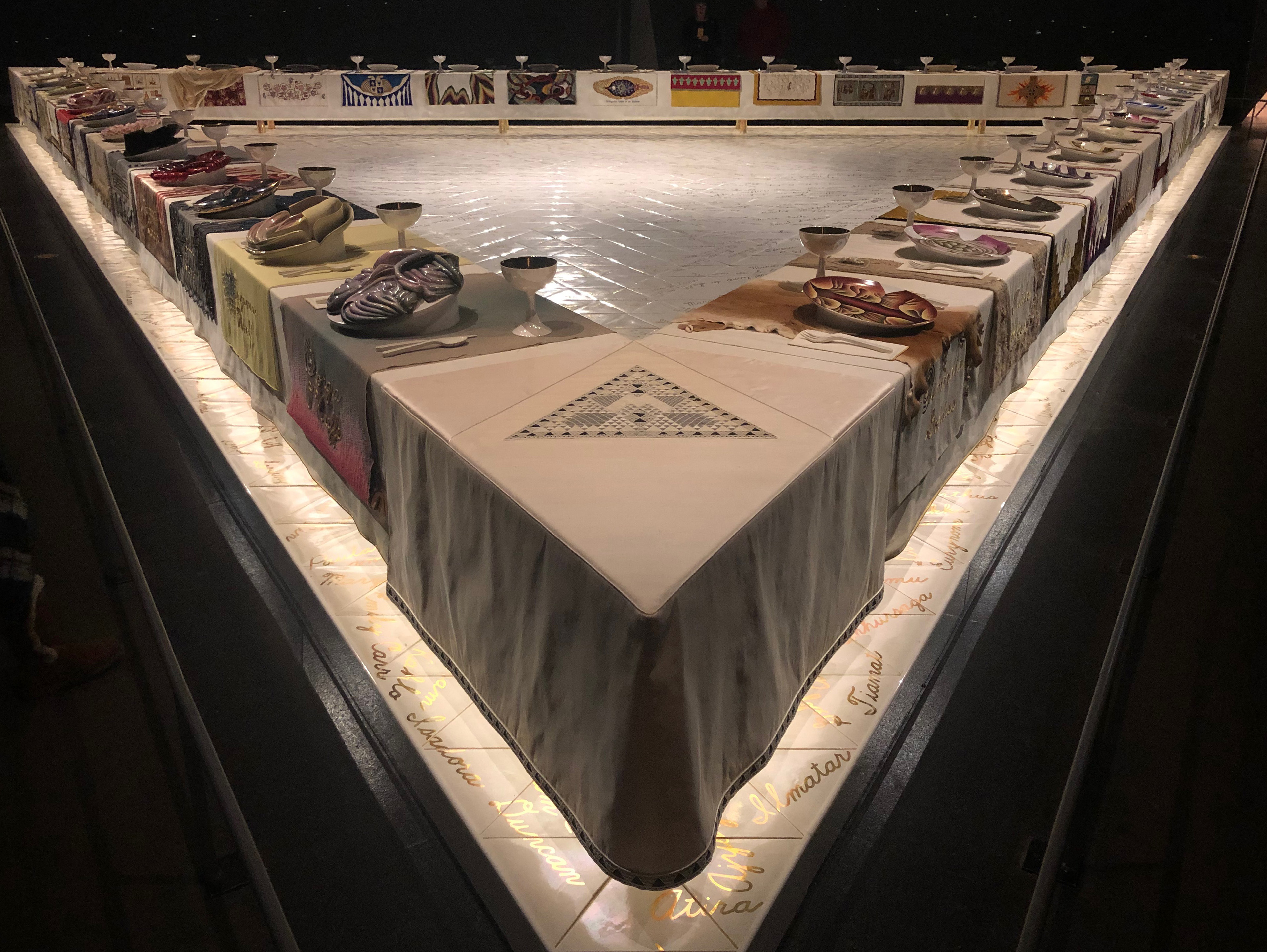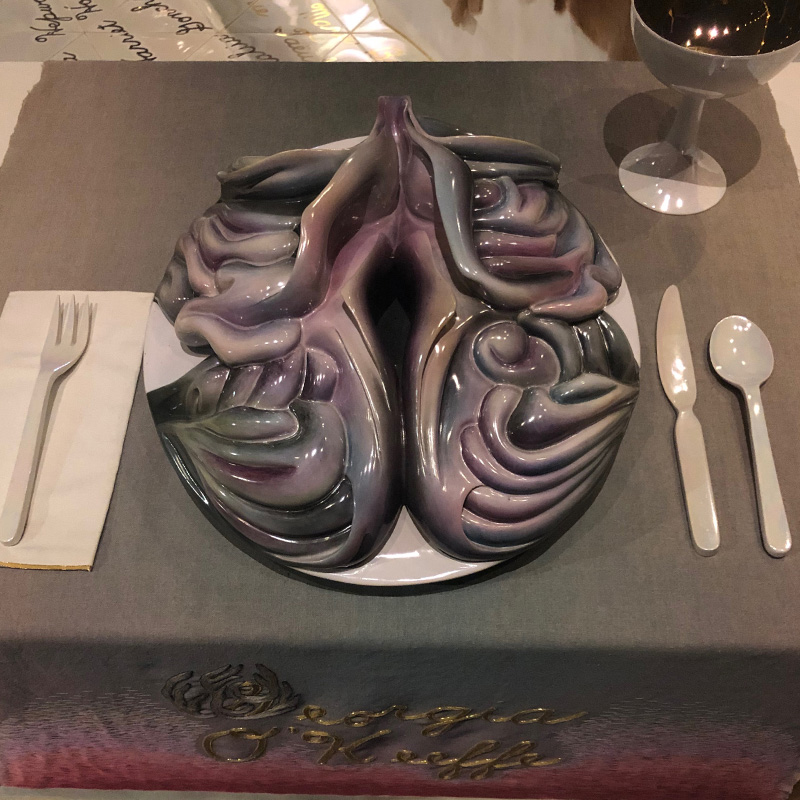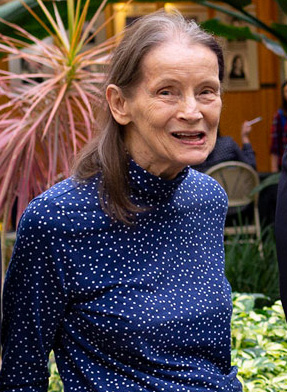
Q&A: Charter faculty member Gretchen Mieszkowski on feminism and ‘The Dinner Party’

Lindsay Humphrey.
Created in the mid-70s by artist Judy Chicago, “The Dinner Party” has been held in high regarded as an iconic work in feminist art. In the last few years, the large installation has seen a reemergence in the press and is being introduced to a new generation.
“The Dinner Party” consists of tables arranged in a triangle, each side 48 feet in length, sitting upon “The Heritage Floor” made up of white triangular tiles. Each tile makes up a total of “999 mythical and historical women of achievement” written in gold luster. The tables are also themed by noteworthy women and feature 39 place settings and an embroidered banner with her name. The place settings are period appropriate and are centered with a colorful, large ceramic plate with a vulva or butterfly design at the center.
It was criticized nationally for showing depictions female vagina despite centuries of men painting thousands of nude male and female models. In addition to detailed sculpted vaginas, Chicago was also looked down upon for using traditionally female trades like embroidery (seen as arts and crafts) and “table setting,” and calling it art.
Its scale and depiction of the female reproductive system being deemed “pornographic,” “The Dinner Party” was shown in few locations across nine years before settling in its final home in 2002 at The Brooklyn Museum. For over a decade, the work was not talked about in the mainstream outside of academia, feminism conversations and “the art world.” Chicago continued to make work themed around feminism and racism, as well as create resources for educators and female artists
Google trends show the search for “The dinner party” begin a steady rise in popularity since July 2016. That month, many Americans had their eyes on the major two parties nominations at the Democratic National Convention and Republican National Conventions. Since then, the searched phrase “The dinner party” has not dipped under 31 percent of its greatest point in popularity which was April of 2018 when she released a line of plates inspired by her installation of “The Dinner Party.” The previous peak of popularity was during the premiere of an episode of the television show “The Office” of the same name in in April 2008.
“The Dinner Party” has reemerged in the wider public’s conscience has been a result of record numbers of people in the United States engaging in activism after the 2016 presidential election. The election was a blow to many feminists who rallied behind the first woman in U.S. history to win a major party nomination for a presidential bid, and found themselves with a winner who had been in the media frequently for making sexist and lewd remarks about women.

The 2017 Women’s March and subsequent nationwide protests have had imagery of feminine artwork, bodies and icons both fictitious and real alike. “The Dinner Party” is an installation that is made up of those same things with the most. The handmade, crocheted “pussy hats” hark to “craft arts” that women have been associated with just like “The Dinner Party.”
Since the “MeToo” movement began taking to the streets, Twitter made it so that when “#metoo” is written it a pink circle with three multi-ethnic hands are raised. Whether on done purposefully or on accident, the symbol has been seen by some Twitter users as the female labia.
“The Silence Breakers,” referring to the voices that launched the MeToo movement, were named Time Magazine’s “Person of the Year” in 2017 and Judy Chicago was named in its Top 100 people of 2018 list.
Those not as well versed in UHCL’s history may be surprised to find that in 1980, the university was the second location to display the “The Dinner Party.” An estimated 36,000 people viewed the work while it was on display. March of 2010, there was a celebration of the 30th anniversary with activities such as yarn bombing, a reception and a special guest lecture with charter faculty member Gretchen Mieszkowski.
Being one of the founding faculty members of UHCL and of the Women’s Studies program, Mieszkowski was teaching literature at the time of “The Dinner Party’s” arrival on campus. The Signal reached out to Mieszkowski to talk about feminism and “The Dinner Party.”

Q: What was it like to be a woman professor at UHCL in the 70s and 80s?
A: The faculty and administrators were a sea of men, but I was teaching Literature and many of my students were women. Often they had studied first at other universities and then moved here when their husbands had taken jobs in area industry or NASA. Many were juggling families and college or graduate classes, but they were grateful that high-quality education was now available to them. They were delighted to have a woman professor and I was delighted to be teaching such interested, exciting students.
Q: How did Dean Calvin Cannon’s bringing “The Dinner Party” to UHCL affect the culture of the humanities department?
A: Staging “The Dinner Party” on top of getting a new university off the ground was exhausting for all of us. But the professors in the Humanities departments were all feminists before they had heard of “The Dinner Party.” And after it left, we continued with establishing Women’s Studies courses and organizing a yearly Women’s Week to encourage more women to think about their heritage and their strengths.
Q: Who are some women, not already represented, would you have loved to see at “The Dinner Party” in 2019? Why?
A: Toni Morrison – one of the most important writers of the late 20th century. But in 1980, when “The Dinner Party” came to UHCL, although Toni Morrison had already published three outstanding novels, she was not yet famous enough for the Chicago group to include her. Her Nobel Prize for Beloved (1993) was still ahead of her.
Q: With this new wave of young people engaged in politics and activism, is there something about it you see that makes you hopeful?
A: I’m tremendously hopeful. 102 women elected to the House of Representatives! Think about what this will mean for attention to our concerns: child care, health care, pre-school education, and that’s just the beginning.

Dr. Mieszkowski was one of my favorite professors when I was at UHCL earning my BA in Literature. She opened my mind in every class and was helpful, patient, and kind to me when I was going through a very rough time. I’m so glad women (and men) at UHCL are still lucky enough to have Dr. Mieszkowski as an instructor.